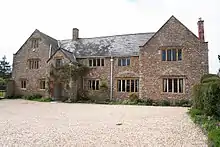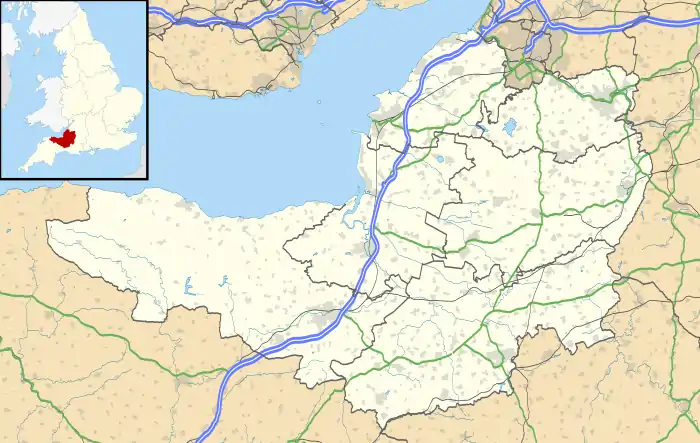Gerbestone Manor
Gerbestone Manor in West Buckland, Somerset, England was largely rebuilt in the late 16th century, although some fabric from the 13th century house remains. It is a Grade II* listed building.[1]
| Gerbestone Manor | |
|---|---|
 | |
| Location | West Buckland, Somerset, England |
| Coordinates | 50.9677°N 3.195°W |
Listed Building – Grade II* | |
| Official name | Gerbestone Manor |
| Designated | 25 January 1956[1] |
| Reference no. | 1344582 |
Listed Building – Grade II | |
| Official name | Barn, about 100 m north of Gerbestone Manor |
| Designated | 7 August 1986[2] |
| Reference no. | 1060287 |
Listed Building – Grade II | |
| Official name | Barn containing squash court, about 30 m west of Gerbestone Manor |
| Designated | 7 August 1986[3] |
| Reference no. | 1180181 |
 Location of Gerbestone Manor in Somerset | |
The house has been owned by a succession of families of local gentry and is now used as a wedding venue and for corporate events. The main two-storey chert stone building is accompanied by various outbuildings including barns and a mill.
History
The Gerbestone estate was created around 1235, when a local knight "Gerebert" was granted an exemption from paying taxes by Bishop Jocelin of Wells.[4] In 1333 Bishop Ralph of Shrewsbury granted a licence for the addition of an oratory. It then passed through a succession of owners and leaseholders until the 1580s.[5]
The current building was largely constructed in the late 16th century including the use of chimneys for the first time.[5] It was further enlarged, with the addition of wings to the house and additional staircases, in the 17th century when owned by the Wyndham family of Orchard Wyndham.[5] In 1612 the owner was Thomas Frances, who married Suzanna, daughter of George Luttrell of Dunster Castle and later it was owned by John Ewell.[4] Suzanna Francis's children married into the families of other local landowners including that of Francis Popham and supported both sides during the English Civil War.[5] In 1693 the house was mortgaged by Nicholas Frauncies and then sold to Sir John Elwell whose descendants lived there until 1894 when it was bought by William Temlett Marke.[5]
Further restoration was undertaken in the 1920s and 1930s by Hubert Lidbetter, for the Lloyd-Fox family who were the owners at the time,[1] which included a new staircase and windows and the removal of all the plaster on walls and ceilings.[5] During World War II the house was used to accommodate 30 evacuees.[5]
In 2007 the house was bought by the investment banker, Spencer Weir, for £2,5 million.[6]
The long barn was converted, with attached watermill, in 2014 and is now used as a wedding and events venue.[4][7] The main house can sleep 24 guests.[8]
The historical records from the manor are held by the South West Heritage Trust.[9]
Architecture
The two-storey house is built of chert stone with Hamstone dressings and slate roofs.[1]
The long barn was built in the 16th or 17th century and has a cruck roof with a bell-cote at its apex.[2] Another 18th-century barn. which had been a pigeon loft,[5] has been converted into a squash court.[3] The estate also had an overshot watermill.[10]
References
- "Gerbestone Manor". National Heritage List for England. Historic England. Retrieved 27 August 2017.
- "Barn, about 100 m north of Gerbestone Manor". National Heritage List for England. Historic England. Retrieved 27 August 2017.
- "Barn containing squash court, about 30 m west of Gerbestone Manor". National Heritage List for England. Historic England. Retrieved 27 August 2017.
- Paltridge, Gill. "Great Long Barn formally opens". Around Wellington. Retrieved 27 August 2017.
- "Gerbestone Manor Wellington Somerset" (PDF). Fox Links. Retrieved 27 August 2017.
- Burroughs, Katrina (6 December 2007). "In a class of their own". Financial Times. Retrieved 27 August 2017.
- "The Great Long Barn". Manor Estate. Retrieved 27 August 2017.
- "UK accommodation gems". Telegraph. Retrieved 27 August 2017.
- "Gerbestone Manor". National Archives. Retrieved 27 August 2017.
- "Watermill, Gerbestone Manor Farm, West Buckland". Mills archive. Retrieved 27 August 2017.
External links
| Wikimedia Commons has media related to Gerbestone Manor. |